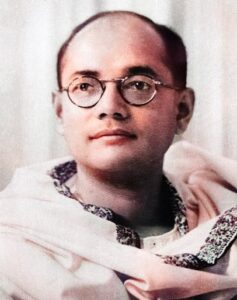Indian National Army (INA)- Modern History Notes for UPSC
Indian National Army
Subhas Chandra Bose (1897-1945) |
|
|
Origin of the Indian National Army
The idea of forming an army was conceived by Mohan Singh, an officer in the British Indian Army. He decided not to join the withdrawing British Indian Army and turned to the Japanese for help.
First Phase of Indian National Army
- The Indian prisoners of war (PoWs), amounting to nearly 45000, were handed over to Mohan Singh by the Japanese.
- The decision to join the Indian National Army was left to the PoWs, and by the end of 1942, nearly 40,000 were willing to join the INA.
- The Army was formed on February 17, 1942, in Singapore.
- It was made clear by the leaders of INA that the Army would go into action only at the invitation of the Congress and the people of India.
- However, by December 1942, serious differences emerged between the Japanese and the leadership of the INA over the role the INA was to play. The Japanese wanted only a token force of 2000 men, contrary to the wishes of the INA, which wanted a strength of 20,000.
- These differences led to the arrest of the two senior officers of the INA, Mohan Singh and Niranjan Singh Gill.
- Role of Rasbehari Bose:
- He was involved in revolutionary activities in India. In 1915, he escaped to Japan and became a naturalised citizen there.
- After the establishment of the Indian National Army in Singapore, Rasbehari Bose left Tokyo for Southeast Asia.
- During the Bangkok Conference (1942), it was decided to put the INA under the Indian Independence League, created by Rasbehari Bose in Tokyo.
The second phase of the movement
- In July 1943, Subhas Chandra Bose reached Singapore, where he met Rasbehari Bose, who transferred the leadership of the League and the INA to Subhash Bose.
- Formation of the provisional Government:
- On October 21 1943, in Singapore, the Provisional Government of Free India (Azad Hind Sarkar) was set up by Subhash Bose with HC Chatterjee (Finance), MA Aiyar (Broadcasting) and Laxmi Swaminathan (Women department).
- Here, Subhash Bose gave the famous slogan, “Give me blood, and I will give you freedom”.
- The provisional government was recognised by the Axis powers. It declared war on Britain and the USA.
- A women’s regiment named Rani Jhansi regiment was formed.
- In November 1943, the Japanese handed over the administration of the Andaman and Nicobar Islands to the provisional government. Bose renamed the two Island groups as Shaheed Dweep (Andaman) and Swaraj Dweep (Nicobar).
- In January 1944, the headquarters of the INA was shifted to Rangoon (
- Burma), from here, the Army was to march towards India with the war cry “Chalo Delhi”.
- In July 1944, Bose addressed Gandhi as “father of the nation” on Azad Hind Radio and asked for his blessings for “India’s last war of independence”.
Action Phase
- On March 18 1944, INA, commanded by Shahnawaz Khan, crossed the Indian frontiers to take part in the Imphal Campaign. They were accompanied by the Japanese Army.
- However, the Imphal campaign proved to be a failure, and with the retreat of the Japanese Army, the hope of the INA liberating the country also diminished.
- The INA campaign ended in mid-1945 with the final surrender to the British in Southeast Asia.
Why did the INA campaigns fail?
- The Japanese Army failed to provide air cover and other essential supplies to the INA.
- Monsoon prevented their advances and gave the British Indian Army enough time to regroup and counterattack.
- The discriminatory attitude of the Japanese, which included denial of rations and forced to do menial work, demoralised the INA.
- The weakening position of the Japanese also significantly affected the campaign.
Impact of Indian National Army
Even though it failed to achieve its goal, it made a significant mark on the Indian freedom struggle.
- It made the British realise that they could not rely on the loyalty of the Indian soldiers.
- The INA struggle demonstrated utmost religious harmony. The INA soldiers belonged to different religions but fought as Indians.
- The INA also had a women’s regiment, which not only demonstrated their capabilities in the armed struggle but also inspired millions of women in India.
- The struggle also demonstrated and utilised the enthusiasm of overseas Indians who contributed heavily to the cause.
- A powerful movement emerged in defence of the INA PoWs when they were brought back to India to be court-martialled. It accelerated the process of British withdrawal.







